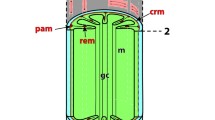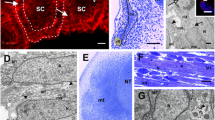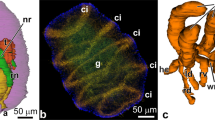Abstract
An antiserum to transdifferentiated striated muscle cells from the medusa of Podocoryne carnea was prepared and used to screen a λ gt11-expression library prepared from gonozoids of P. carnea. We isolated a cDNA clone termed Pod-EPPT with at least 63 tandem repeats of the tetrapeptide-motive glu-pro-pro-thr, named Pod-EPPT. Using Pod-EPPT as a molecular marker for head quality the morphological relationship between the two metagenic life stages of this hydroid, the polyp and the medusa, was studied. In situ hybridization demonstrated that expression of the gene corresponding is restricted to secretory cells in the endoderm of the oral hypostome region of polyps and medusae and, presumably, to progenitor cells of this type. Cells expressing Pod-EPPT could not be observed in the larval stage. During head regeneration in polyps, Pod-EPPT expression is upregulated soon after head removal in previously non-expressing cells and in newly differentiating secretory cells. This activation of a head-specific gene precedes the morphologically obvious events of head regeneration. Pod-EPPT is one of the genes that are activated during manubrium (mouth) regeneration from experimentally combined subumbrellar plate endoderm and striated muscle of the medusa.
Similar content being viewed by others
References
Alder H, Schmid V (1987) Cell cycles and in vitro transdifferentiation and regeneration of isolated, striated muscle of jellyfish. Dev Biol 124:358–369
Bally A, Schmid V (1987) The jellyfish and its polyp: a comparative study of gene expression monitored by the protein patterns, using twodimensional gels with double-label autoradiography. Cell Dif. 23:93–102
Blau HM, Pavlath BK, Hardeman EC, Chin CP, Silberstein L, Webster SG, Miller SC, Webster C (1985) Plasticity of the differentiated state. Science 230:758–766
Bouillon J (1966) Les cellules glandulaires des Hydroïdes et Hydroméduses. Leur structure et la nature de tents sécrétions. Cah Biol Mar 7:157–205
Brien P (1953) La pérennité somatique. Biol Rev 28:308–349
Chirgwin JM, Przybyla AE, MacDonald RJ, Rutter WJ (1979) Isolation of biologically active ribonucleic acid from sources enriched in ribonuclease. Biochemistry 18:5294–5299
Davis LG, Dibner MD, Battey JF (1986) Basic methods in molecular biology. Elsevier, New York
Devereux J, Heberli P, Smithies O (1984) A comprehensive set or sequence analysis programs for the VAX. Nucleic Acids Res 12:387–395
DiBerardino MA (1988) Genomic multipotentiality of differentiated somatic cells. Cell Diff Dev 25 (Suppl.): 129–136
DiBerardino MA, Hoffner IN, Etkin LD (1984) Activation of dormant genes in specialized cells. Science 224:946–952
Giorda R, Ohmachi T, Shaw DR, Ennis HL (1990) A shared internal threonine-glutamic acid-threonine-proline repeat defines a family of Dictyostelium discoideum spore germination specific proteins. Biochemistry 29:7264–7269
Gurdon JB (1992) The generation of diversity and pattern in animal development. Cell 68:185–199
Itch Y, Eguchi G (1986) In vitro analysis of cellular metaplasia from pigmented epithelial cells to lens phenotypes: A unique model system for studying cellular and molecular mechanisms of “transdifferentiation”. Dev Biol 115:353–362
Korge G (1975) Chromosome puff activity and protein synthesis in salivary glands of Drosophila melanogaster. Proc Nat Acad Sci USA 72:4550–4554
Korge G (1977) Larval saliva in Drosophila melanogaster: production, composition, and relationship to chromosome puffs. Dev Biol 58:339–355
Kutz E, Schmid V (1991) Effects of tumor promotors and diacylglycerol on the transdifferentiation of striated muscle cells of the medusa Podocoryne carnea to RF-amide positive nerve cells. In: Williams RB, Cornelius PFS, Hughes RG, Robson EA (eds) Hydrobiologia 216/217. Kluwer Academic Publishers, pp 11–17
Laemmli UK (1970) Cleavage structural proteins during the assembly of the head of bacteriophage T4. Nature 227:680–685
Mitashov VI (1989) Mechanisms of transdifferentiation of pigment epithelial cells into neural retina; A hypothesis. In Kiorstis V, Koussoulakos S, Wallace H (eds) Recent trends in regeneration research. Plenum, New York, pp 275–280
Müller WA, Buchal G (1973) Metamorphose-Induktion bei Planulalarven. II. Induktion dutch monovalente Kationen: Die Bedeutung des Gibbs Donnan-Verhältnisses und der Na+/K+-ATPase. Roux's Arch. 173:122–135
Muskavitch MAT, Hogness DS (1982) An expandable gene that encodes a Drosophila glue protein is not expressed in variants lacking remote upstream sequences. Cell 29:1041–1051
Okada TS (1991) Transdifferentiation, Flexibility in cell differentiation. Clarendon Press, Oxford
Proudfoot N (1991) Poly(A) signals. Cell 64:671–674
Sanger, F, Nicklen, S, Coulson, AR (1977): DNA sequencing with chain terminating inhibitors. Proc Natl Acad Sci USA 74:5463–5467
Sambrook J, Fritsch EF, Maniatis T (1989) Molecular Cloning: a laboratory manual, 2nd edn. Cold Spring Harbor Laboratory, Cold Spring Harbor, NY
Schmid V (1974) Structural alterations in cultivated striated muscle cells from anthomedusae. Exp Cell Res 86:193–198
Schmid V (1975) Cell transformation in isolated striated muscle of hydromedusae independent of DNA synthesis. Exp Cell Res 94:401–408
Schmid V (1979) The establishment of an in vitro regeneration system using anthomedusae. Annales de la société française de biologie du développement, (Banyuls-sir-mer):35–38
Schmid V (1980) The in vitro regeneration of a functional medusa organ from two differentiated cell types. In: Kurstak E, Maramorosch K (eds) Invertebrate tissue culture. Academic Press, New York, pp 89–101
Schmid V (1988) The potential for transdifferentiation and regeneration of isolated striated muscle of medusae in vitro. Cell Diff 22:173–182
Schmid V (1992) Transdifferentiation in medusae. Int Rev Cytol 142:213–261
Schmid V, Alder H, Plickert G, Weber C (1988) Transdifferentiation from striated muscle of medusae in vitro. In: Eguchi G, Okada TS, Saxén L (eds) Regulatory Mechanisms in developmental processes. Elsevier Scientific, Dubein, pp 137–146
Schmid V Wydler M, Alder H (1982) Transdifferentiation and regeneration in vitro. Dev Biol 92:476–488
Tardent P (1977) Coelenterata, Cnidaria. In: Seidel F (ed) Morphogenese der Tiere. Gustav Fischer, Jena
Tautz D, Pfeifle C (1989) A nonradioactive in situ hybridization method for the localization of specific RNAs in Drosophila embryos reveals translational control of the segmentation gene hunchback. Chromosoma 98:81–85
Thomas MB, Edwards NC (1991) Cnidaria: Chapter 4, Hydrozoa. In: Harrison FW, Westfall J (ed). Microscopic Anatomy of Invertebrates: Placozoa, Porifera, Cnidaria, and Ctenophora, 2. Wiley-Liss, New York, pp 91–183
Van de Vyver G (1964) Etude histologique du developpement d'Hydractinia echinata (Flem.). Cah Biol Mar 5:295–310
Weber C (1989) Smooth muscle fibers of Podocoryne carnea (Hydrozoa) demonstrated by a specific monoclonal antibody and their association with neurons showing FMRFamide-like immunoreactivity. Cell Tissue Res 255:275–282
Wolff G (1895) Entwickelungsphysiologische Studien. I. Die Regeneration der Urodelenlinse. Roux's Arch Dev Biol 1:380–390
Author information
Authors and Affiliations
Rights and permissions
About this article
Cite this article
Baader, C.D., Schuchert, P., Schmid, V. et al. Temporally and spatially restricted expression of a gland cell gene during regeneration and in vitro transdifferentiation in the hydrozoan Podocoryne carnea. Roux's Arch Dev Biol 204, 164–171 (1995). https://doi.org/10.1007/BF00241268
Received:
Accepted:
Issue Date:
DOI: https://doi.org/10.1007/BF00241268




